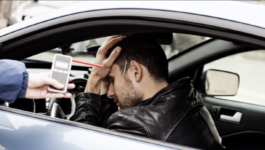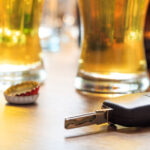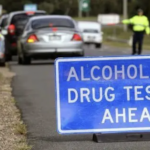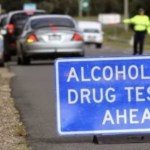Drink Driving in New South Wales: Laws, Defences and Penalties

As we head into the holiday period, it’s perhaps timely to provide a reminder that drink driving is a crime in New South Wales – one which can have serious and lasting consequences in terms ones ability to drive, their ability obtain or continue employment and even, in some cases, the to travel and obtain other forms of licences.
Perhaps it’s also important to be aware that alcohol can remain in the bloodstream for many hours, so while you may feel tired the morning after a big night out, it may be the case that you still have alcohol in your system – which could land you on the wrong side of the law if you are pulled over by the roadside, or worse, inadvertently cause you to put others in danger.
Here’s a rundown of the rules that apply when it comes to prescribed concentration of alcohol offences (commonly known as ‘drink driving’), driving while under the influence of alcohol and the more recent combined offence of drink and drug driving.
What is drink driving?
Drink-driving offences could be encompassed by a variety of offences under the Road Transport Act 2013, including prescribed concentre of alcohol offences (also known as PCA offences), the offence of driving under the influence and the newly implemented offence of combined drink driving and drug driving.
Prescribed concentration of alcohol offences
A number of drink driving offences are contained in section 110 of the Road Transport Act 2013.
These offences relate to situations where a driver registers a reading at or above what is known as the prescribed concentration of alcohol in their breath or blood.
Section 198 of the Act outlines the various ranges of prescribed concentrations of alcohol, which are novice range, special range, low range, middle range and high range.
A novice drink driving offence will be committed if a learner or provisional driver licence holder is detected with a blood alcohol concentration of between 0.001 and 0.019.
A special range drink driving offence will be committed if a learner or provisional driver licence holder is detected with a blood alcohol concentration of between 0.020 and 0.049.
A low range drink driving will be committed if a driver is detected with a blood alcohol concentration of between 0.05 and 0.079.
A mid-range drink driving offence will be committed if a driver is detected with a blood alcohol concentration of between 0.08 and 0.149.
A high range drink driving offence will be committed if a driver is detected with a blood alcohol concentration of at least 0.15.
Driving under the influence offence
Under section 112 of the Road Transport Act, an offence will be committed if a person operates a vehicle (including occupying the driving seat of a vehicle or supervising a provisional driver) whilst under the influence of alcohol or any other drug.
Driving under the influence is usually a charge used in situations where it isn’t possible to get an accurate reading of your blood alcohol level.
Combined drink-driving and drug-driving offence
Section 111A of the Road Transport Act 2013, outlines an offence where a person has both a prescribed illicit drug in their system along with being above the prescribed concentration of alcohol (as per above).
Penalties for drink-driving offences
The potential penalties for the drink-driving offence will be depend on what offence you’ve been charged with and whether this is your first offence.
Novice drink-driving offence
If novice drink-driving is your first major traffic offence within the past 5 years and you choose to have the case dealt with in court are:
- 3 months of disqualification from driving, and
- Maximum fine of $2,200.
If it is your 2nd or more major traffic offence within 5 years, the penalties are:
- 3-month disqualification which can be reduced to 1 month, followed by
- 12 months during which you must have an interlock device installed to your vehicle, and
- Maximum fine of $3,300.
Special range drink-driving offence
If special range drink-driving is your first major traffic offence within the past 5 years and you choose to have the case dealt with in court are:
- 6 months of disqualification from driving, and
- Maximum fine of $2,200.
If it is your 2nd or more major traffic offence within 5 years, the penalties are:
- 3-month disqualification which can be reduced to 1 month, followed by
- 12 months during which you must have an interlock device installed to your vehicle, and
- Maximum fine of $3,300.
Low range drink-driving offence
If low range drink-driving is your first major traffic offence within the past 5 years and you choose to have the case dealt with in court are:
- 6 months of disqualification from driving, which can be reduce to a minimum of 3 months, and
- Maximum fine of $2,200.
The penalties where it is your first major traffic offence within the past 5 years and you choose to have the case dealt with in court are:
- 6 months of disqualification from driving, which can be reduce to a minimum of 3 months, and
- Maximum fine of $2,200.
Middle range drink-driving offence
If mid-range drink driving is your first major traffic offence within the past 5 years, the maximum penalties are:
- Up to 9 months in prison
- 6 month driver licence disqualification which can be reduced to 3 months, followed by
- 12 months during which you must have an interlock device installed to your vehicle, and
- Fine of $2,200
Alternatively, the court can ‘exempt’ you from the interlock requirement and impose maximum penalties of:
- Up to 9 months in prison
- 12 month licence disqualification which can be reduced to 6 months, and
- Fine of $2,200.
If it is your second or more major traffic offence in the past 5 years the maximum penalties are:
- Up to 12 months in prison
- 9 month licence disqualification which can be reduced to 6 months, followed by
- 24 months during which you must have an interlock device installed to your vehicle, and
- Fine of $3,300
Alternatively, the court can ‘exempt’ you from the interlock requirement and impose maximum penalties of:
- Up to 12 months in prison
- 3 year licence disqualification which can be reduced to 12 months, and
- Fine of $3,300
But whether it is your first, or second or more, major traffic offence within the past 5 years, there will be no criminal record, licence disqualification or fine where the court deals with you by way of a section 10(1)(a) dismissal, or conditional release order without a conviction – which you may seek unless you have received a non-conviction order for a major traffic offence in the previous 5 years.
High range drink-driving offence
If high-range drink driving is your first major traffic offence within the past 5 years, the maximum penalties are:
- Up to 18 months in prison,
- 9 month driver licence disqualification which can be reduced to 6 months, followed by:
- 24 months during which you must have an interlock device installed to your vehicle, and
- Fine of $3,300.
Alternatively, the court can ‘exempt’ you from the interlock requirement and impose maximum penalties of:
- Up to 18 months in prison,
- 3 year licence disqualification which can be reduced to 12 months, and
- Fine of $3,300.
If it is your second or more major traffic offence in the past 5 years the maximum penalties are:
- Up to 2 years in prison,
- 12 month licence disqualification which can be reduced to 9 months, followed by:
- 48 months during which you must have an interlock device installed to your vehicle, and
- Fine of $5,500.
Alternatively, the court can ‘exempt’ you from the interlock requirement and impose maximum penalties of:
- Up to 2 years in prison,
- 5 year licence disqualification which can be reduced to 2 years, and
- Fine of $5,500.
Driving under the influence offence
If it is your first major traffic offence in 5 years, the maximum penalty is a fine of $2,200 and/or 9 months imprisonment.
There is also an ‘automatic’ period of disqualification from driving of 3 years which can be reduced by the court to 12 months if there are good reasons to do so.
If the DUI involves alcohol (rather than other drugs), a ‘mandatory interlock order’ applies.
This means the court must order you to spend between 6 and 9 months off the road, before installing a device known as an ‘interlock device’ into your vehicle and having it there for 24 months.
If it is your second or more major traffic offence in the past five years, the maximum penalty is a fine of $3,300 and/or imprisonment for 12 months.
The automatic period of disqualification is 5 years which can be reduced by the magistrate to 2 years.
Again, if the DUI involves alcohol (rather than other drugs), a ‘mandatory interlock order’ will apply.
In this case, the court will need to order you to spend 9 to 12 months off the road, followed by a period of 48 months with an interlock device installed.
Combined drink-driving and drug driving offence
If it is the driver’s first ‘major traffic offence’ within the past 5 years, the maximum penalty is 2 years imprisonment and/or a fine of up to $5,500.
The offence also comes with an ‘automatic’ period of disqualification from driving of 4 years, which can be reduced by a court to a minimum of 18 months.
A second or subsequent offence carries, again, up to 2 years imprisonment but the maximum fine is increased to $11,000. The automatic disqualification in these cases is 6 years, which can be reduced to a minimum of 3 years.
The second type of offence is for mid-range drink driving with the presence of a drug. A first offence carries a maximum of 18 months inside and/or a $3,300 fine. The automatic disqualification is 2 years, which can be reduced to 12 months.
A second or subsequent offence carries 2 years and/or a $6,600 fine. The automatic disqualification is 4 years, which can be reduced to 2 years.
The third tier of offence relates to those who have been convicted of one of the above offences within the previous five years, and are then caught driving with a novice range (0.00 and below 0.019 alcohol concentration for a learner, provisional or unlicensed driver), special range (0.02 and 0.049 for a learner, provisional or unlicensed driver) or low range (0.05 and 0.079 for a fully licensed driver) prescribed concentration of alcohol, with the presence of an illicit drug.
The maximum penalty in such cases is 18 months in gaol and/or a fine of $5,500. The automatic disqualification is 2 years, which can be reduced to 18 months.
A ‘mandatory interlock order’ will apply to any of these offences.
The alcohol interlock program
The Alcohol Interlock Program is where a court orders a driver to have a device installed into his or her vehicle whereby a breath sample must be provided before the ignition can activate.
An alcohol interlock order must be made where a driver is convicted for mid or high range drink driving, driving under the influence offence or combined drink-driving and drug-driving offence unless the court grants an exemption.
Although the alcohol interlock program is described as ‘mandatory’ for specified offences, the court has the power to ‘exempt’ a person from the program and impose a (normally longer) disqualification period instead.
However, the court can only do this where a person (or a lawyer on his or her behalf) demonstrates that:-
For the offence of mid-range drink driving:
- An interlock order would cause severe hardship, and
- An interlock exemption order is more appropriate in all of the circumstances.
For other offences:
- You do not have access to a car, and
- You have a medical condition which prevents you from providing a sufficient sample of breath and the interlock device cannot be modified to accommodate for this.
To establish you do not have a car, you will normally need to show that:
a) You are not the owner, part owner or registered operator of a car,
b) You do not share a car with an owner, part owner or registered operator,
Or if you are either of the above:
c) It is nevertheless unreasonable to require you to install the device.
The application for an exemption is made during the sentencing proceedings in court, which is after you’ve entered a plea of guilty or been found guilty of the relevant offence.
Defences for drink-driving offences
There are a variety of potential defence strategies to drink-driving offences.
Some of the key defences are outlined below.
Unsafe Reading
The most frequent defence to ‘drink driving’ is that a driver’s blood alcohol concentration may have been lower at the time of driving than later when analysed by police.
Studies make it clear that a person’s blood alcohol concentration rises for between 30 minutes and 1 hour after their last alcoholic drink.
This means, for example, that if someone has a few ‘quick drinks’ and gets ‘behind the wheel’ their blood alcohol concentration may be significantly lower when driving than 30 minutes or an hour later when tested on the ‘breath analysis’ machine.
Several factors can determine whether a driver’s reading when driving was likely to be lower than when tested.
These factors include:
- age, sex and weight,
- when and what food was consumed,
- number and type of alcoholic drinks,
- time of first and last drink,
- time of ‘roadside breath test’, and
- time of ‘breath analysis’.
Depending on the particular circumstances of your case, a good lawyer may be able to obtain a ‘pharmacological report’ and use it to:
- request withdrawal of the charge;
- request reduction of the charge-type, eg from ‘high range PCA’ to ‘mid range PCA’, and/or
- to defend the charge at a hearing.
The ‘Two-Hour’ Rule
Police are not permitted to breath test a person more than 2 hours after the person last drove.
If they do so and seek to rely on the reading, the evidence may be excluded by the court.
The ‘Home Safely’ Rule
Similarly, it is illegal for police to require a person to undergo a breath test on his or her own property.
If they do so, the evidence can be excluded by the court.
Honest and Reasonable Mistake
This defence is available to persons who ‘honestly and reasonably’ believed they were under the limit when driving.
It is often easy to prove that a person’s mistake was ‘honest’.
However, it is becoming more and more difficult to prove that it was ‘reasonable’.
This is because there is so much advertising about not ‘drinking and driving’ at all.
However, there are a range of circumstances where the defence is available, including where a person’s drink was ‘spiked’ and they believed they were fatigued rather than affected by alcohol, and limited situations where a significant amount of time has elapsed since the last drink, such as where a person drove ‘the afternoon after’ drinking.
General legal defences
General defences that apply to all criminal offences also apply to drink driving charges.
These defences include duress, necessity, automatism and self-defence.
In the event there is evidence of any such defence, the onus then shifts to the prosecution to prove beyond a reasonable doubt that the defence does not apply to the circumstances of the case.
A person is entitled to a finding of not guilty if the prosecution is unable to discharge this onus.
Can I avoid a licence disqualification for drink driving?
If a person pleads guilty to, or found guilty of, a drink driving offence will avoid a criminal conviction, driver licence disqualification and a fine if the court is persuaded to impose a ‘non conviction order’ such as a section 10 dismissal or a conditional release order without conviction.
In these circumstances, the prospects of avoiding such negative outcomes is increased where a person completes a traffic offender program, prepares a letter of apology to the court and has others prepare character references for them, and provides any other material which explains the offence as well as the impact of a conviction and/or licence disqualification.
Can I drink alcohol whilst driving?
Drinking alcohol while using a motor vehicle has been an offence in New South Wales for over a decade.
The prohibition is contained in regulation 298-1 of the NSW Road Rules 2014, which states that “[a] driver must not consume alcohol while driving”.
A penalty notice for the offence comes with a fine of $349 and 3 demerit points.
The maximum fine is $2,200 if the matter is dealt with in court.
Notable drink-driving cases
There have been a number of notable drink-driving cases in NSW, hitting the extreme end of taking a risk on our roads.
10 Times Over Limit
Queensland woman Angela Bisson was found passed-out on her steering wheel last month. She was taken to hospital and returned a blood alcohol reading of 0.48 – almost ten times over the legal limit.
This is believed to be the highest blood alcohol concentration (BAC) of anyone charged with drink driving in Australia – a level that doctors say could easily have killed her.
Citizen’s Arrest Stops Drunk Driver
In 2016, a NSW man travelling in Queensland made headlines for his dangerous manner of driving.
Shortly after getting behind the wheel, he crashed into a parked station wagon. Undeterred, he continued driving and had another crash, this time hitting a stationary truck. He nevertheless persevered, veered onto the wrong side of the road and crashed into the gutter.
Observing the incident, a nearby witness performed a citizen’s arrest on the man – detaining him until police arrived.
Fortunately, the man sustained only minor injuries and no one else was injured, although several vehicles were damaged.
Tragic Consequences of Drink Driving
24-year-old Miami woman Mila Dago sent several text messages to her ex boyfriend before getting behind the wheel drunk. The messages included “driving drunk woo”, “I’ll be dead thanks to you”, and “Lata.”
Just three minutes later, she drove through a red light and crashed into a pickup truck, killing her 22-year-old passenger. Ms Dago’s BAC was found to be 0.178.
She was sentences to four years imprisonment last month, followed by a period of 10 years of probation and community service. The sentence is the mandatory minimum that can be imposed under Florida state laws for the offence.
Just Waiting for a Mate
A list of extreme drink drivers would not be complete without mentioning Clinton, the famous face behind the ‘I’m just waiting for a mate’ video.
For those who need a reminder, police found Clinton sitting in the driver’s seat of a car which appeared to have just crashed. Police had been alerted to the incident by witnesses who reported a car doing burnouts. But upon arrival, Clinton assured police that he had not been driving, but was simply ‘waiting for a mate.’
Clinton inspired several memes and Facebook fan pages – one of which has almost 40,000 likes.
Going to court for a traffic offence?
If you are going to court for a traffic offence, call or email Sydney Criminal Lawyers anytime to arrange a free first consultation with an experienced, specialist traffic lawyer who will accurately advise you of your options, the best way forward, and fight for the optimal outcome in your specific situation.







